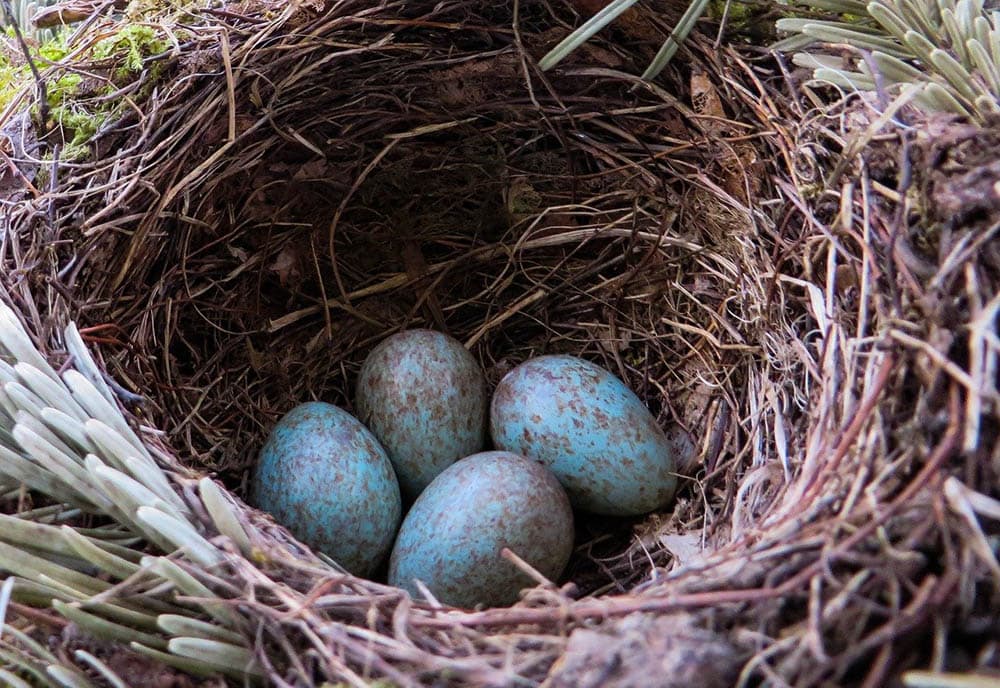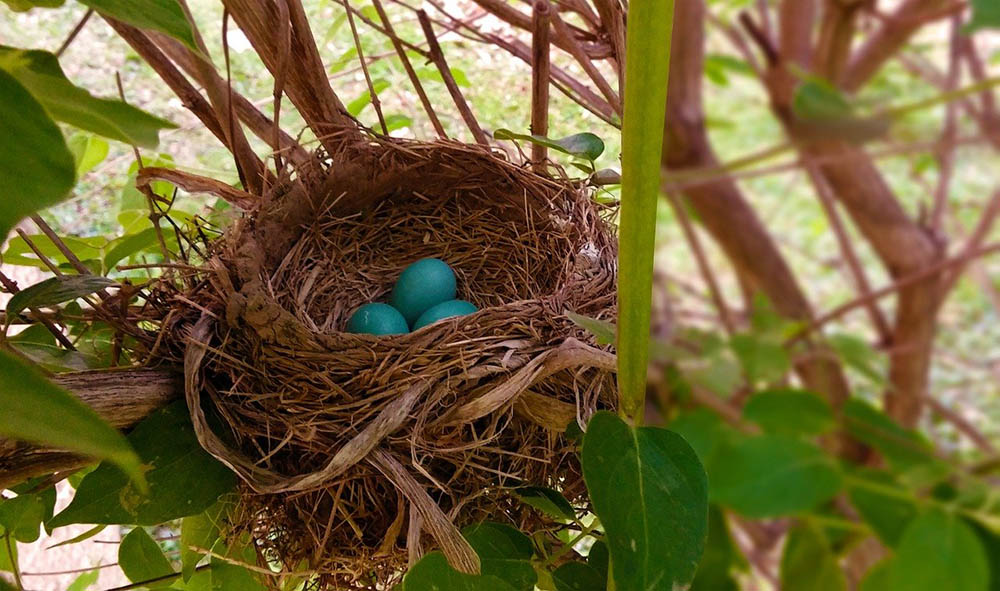What Birds Lay Blue Eggs and Why Does It Happen?
Last Updated on

A nest full of eggs is one of the hallmark images of spring. The color of the eggs may change from person to person, and some see a nest filled with beautiful, bright blue eggs. Some birds, including robins, blue jays, and snowy egrets, lay blue eggs, but why do they? Does it serve an evolutionary purpose? Here’s what science says!

Birds That Lay Blue Eggs
Here’s a short list of common birds that lay blue eggs:
- American Robin
- Bluebird
- Bluejay
- Blackbird (Eurasian blackbird)
- Dunnock
- Goldfinch
- House Finch
- Magpie
- Song Thrush
- Snowy Egret
- Starling

What Makes Some Bird Eggs Blue?
The compound that makes birds blue is called biliverdin. Biliverdin is a pigment present in the bile of certain birds. Biliverdin is also the compound that gives some moth and butterfly wings bluish tones as well as causing bruises in humans to turn blue or greenish. Different pigment concentrations will result in various shades of blue, from bright blue to pale ice blue.
What Benefits Does the Color Provide?
Knowing what makes the eggshell blue doesn’t answer the question of why. Natural selection means that those with the proper evolutionary advantages or lack of disadvantages will survive to pass on their superior genetics. What benefits does the blue coloration of the eggs provide for birds?
1. Protection From the Sun
One reason for the coloration is to protect the eggs from the sun. The sun’s radiation and heat can influence or even kill the unhatched chicks. A dark-colored egg will have better protection from harmful ultraviolet radiation but will heat up faster when exposed to sunlight. A light-colored egg is more susceptible to ultraviolet radiation but will remain cooler when exposed to sunlight.
Due to the differences in how light affects the different biomes worldwide, the color of a bird’s eggs can be traced to its habitat and egg-laying habits. Birds who lay their eggs out in the open will generally have light-colored eggs, while birds who lay eggs in concealed areas will have darker-colored eggs.
Birds need to strike a balance of egg coloration based on their specific habitat and other needs. This process takes thousands of generations to complete, and, as a result, even birds of the same species will have slightly different egg coloration depending on their specific habitat.

2. Parental Health
So long as the color is within the standard colors for the species, more brightly colored eggs represent better parental and future chick health. Poor health of either the mother or the chicks could result in a discoloration of the eggs.
The color of the shell is determined by the shell gland in the mother bird’s body. The shell gland is located at the end of the oviduct before the cloaca. The shell gland forms the egg’s shell just moments before the egg is laid.
Poor diet, illness, or other factors can influence the coloration of the egg’s shell. Birds spend generations upon generations perfecting the shell coloration of their eggs for their specific habitats and environmental circumstances; discoloration of the eggs can indicate whether the mother and chicks are healthy.
3. Brood Parasites
Brood Parasites lay their eggs in other birds’ nests and leave the hatchlings raised by other birds. An egg of a different color than the rest of the eggs in the nest can signify to the bird that something is amiss. Experienced birders can even tell the difference between the eggs by their colors.
Brown-headed cowbirds and common cuckoos are among many birds out there that will lay their eggs in unattended nests and leave the hapless mother to nurture the hatchlings compulsorily. Eggs that look wildly different from the eggs the mother left are a good sign to her that there’s an invader in the ranks.

Conclusion
Evolution is a tricky thing and understanding the nuances of how a trait can benefit a creature can be challenging. Birds’ eggs vary in color and size and understanding why and how is one of the many steps that aspiring birders need to take!
See Also:
Featured Image Credit: foto-augenblick, Pixabay
About the Author Robert Sparks
Robert’s obsession with all things optical started early in life, when his optician father would bring home prototypes for Robert to play with. Nowadays, Robert is dedicated to helping others find the right optics for their needs. His hobbies include astronomy, astrophysics, and model building. Originally from Newark, NJ, he resides in Santa Fe, New Mexico, where the nighttime skies are filled with glittering stars.
Related Articles:
How to Clean a Refractor Telescope: Step-by-Step Guide
How to Clean a Telescope Eyepiece: Step-by-Step Guide
How to Clean a Rifle Scope: 8 Expert Tips
Monocular vs Telescope: Differences Explained (With Pictures)
What Is a Monocular Used For? 8 Common Functions
How to Clean a Telescope Mirror: 8 Expert Tips
Brightfield vs Phase Contrast Microscopy: The Differences Explained
SkyCamHD Drone Review: Pros, Cons, FAQ, & Verdict
